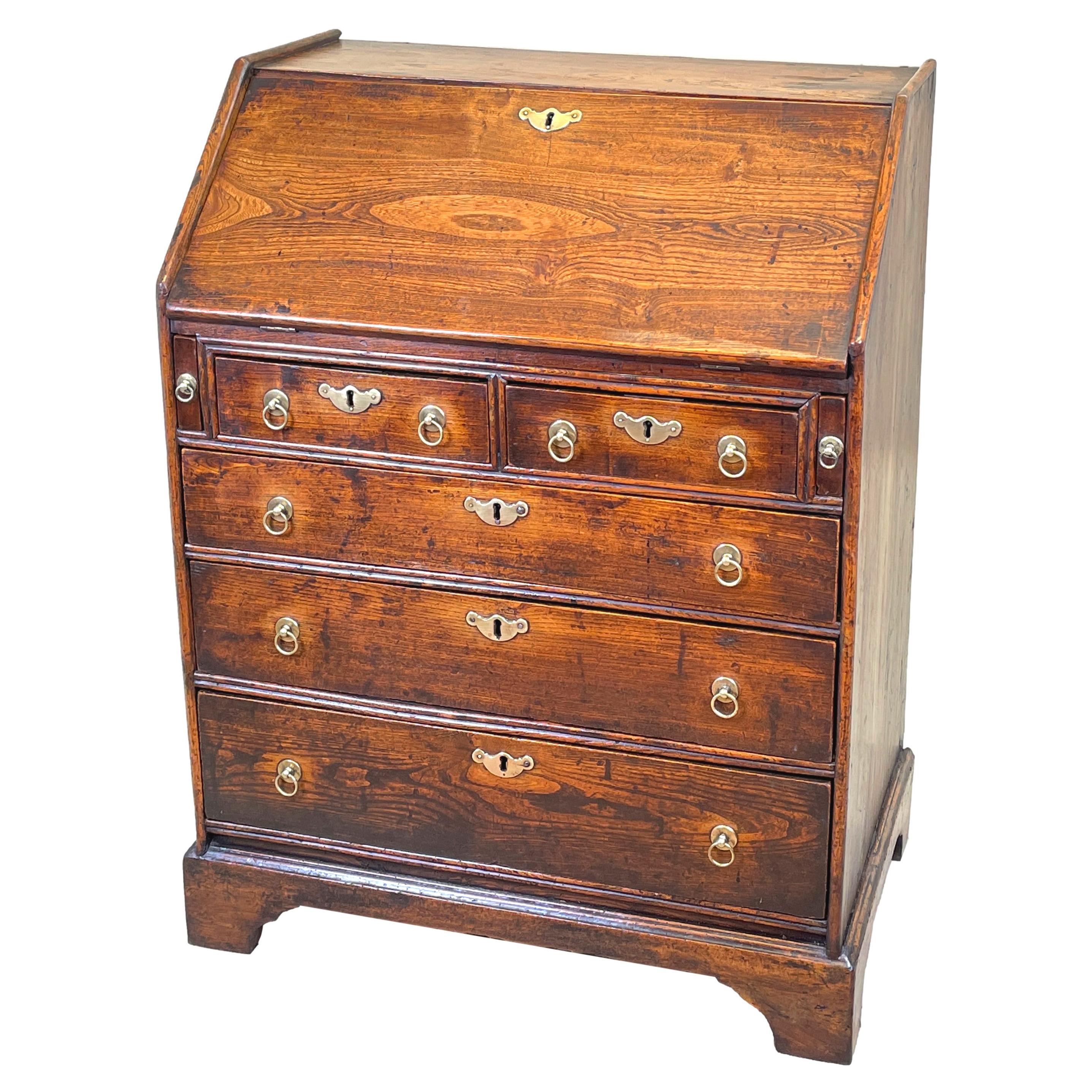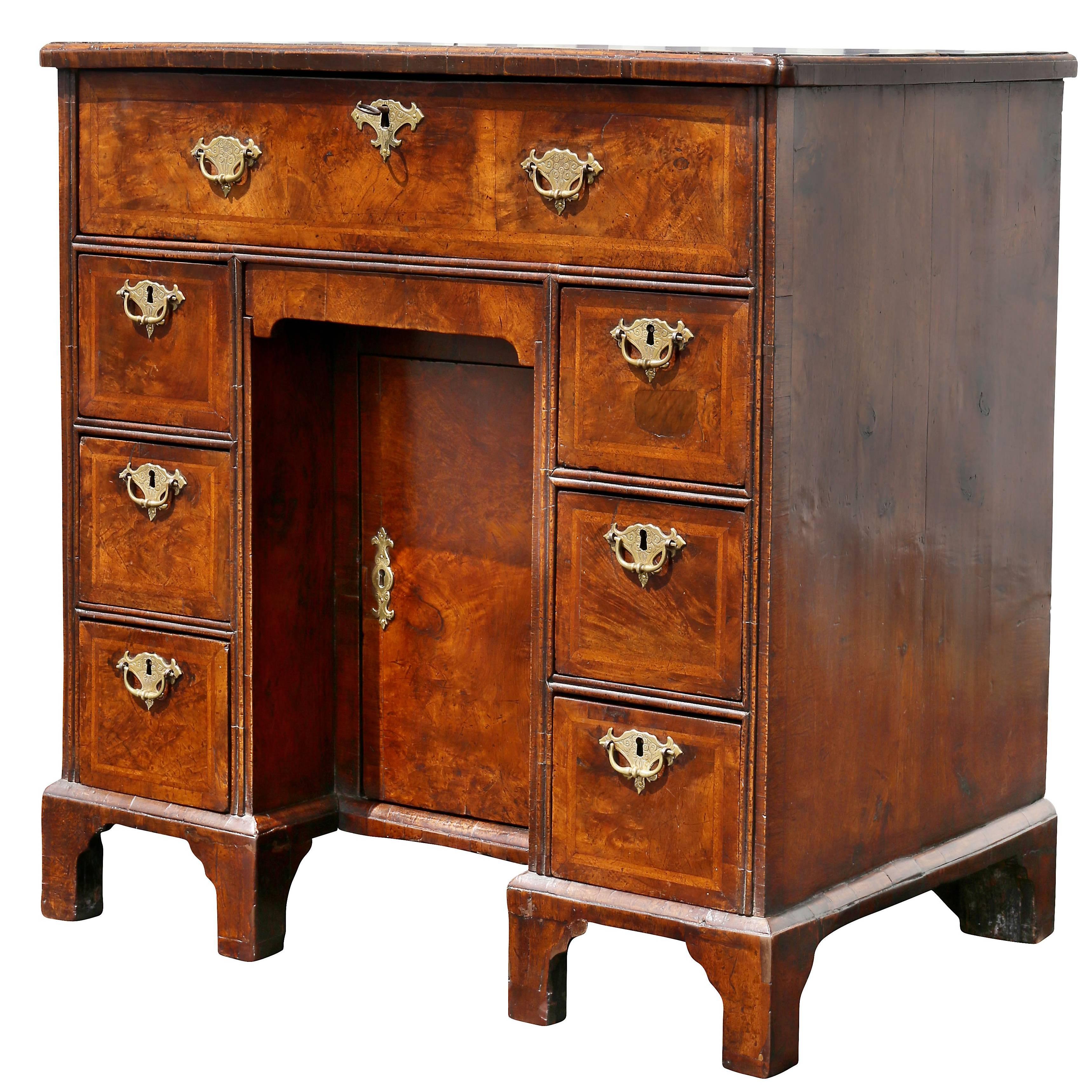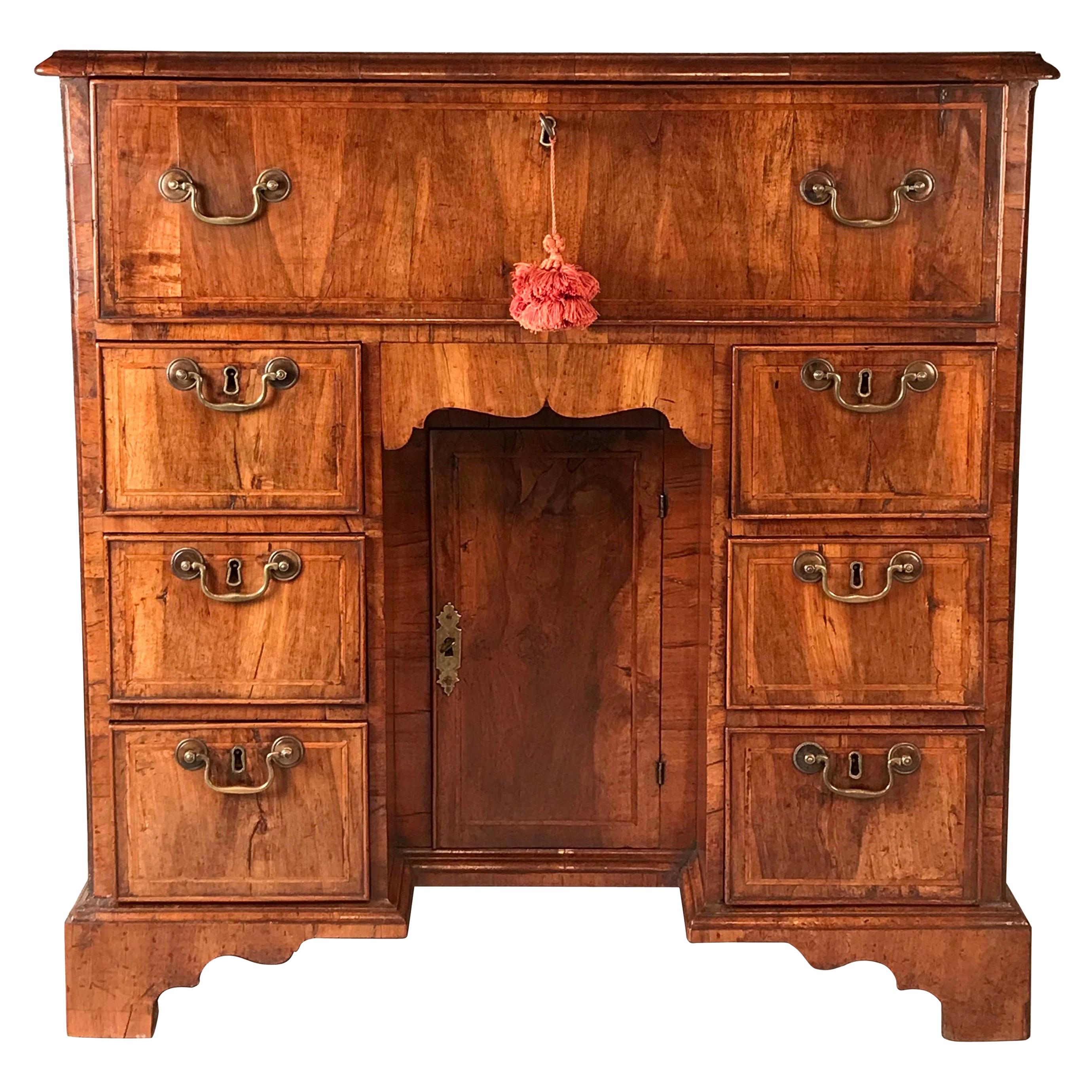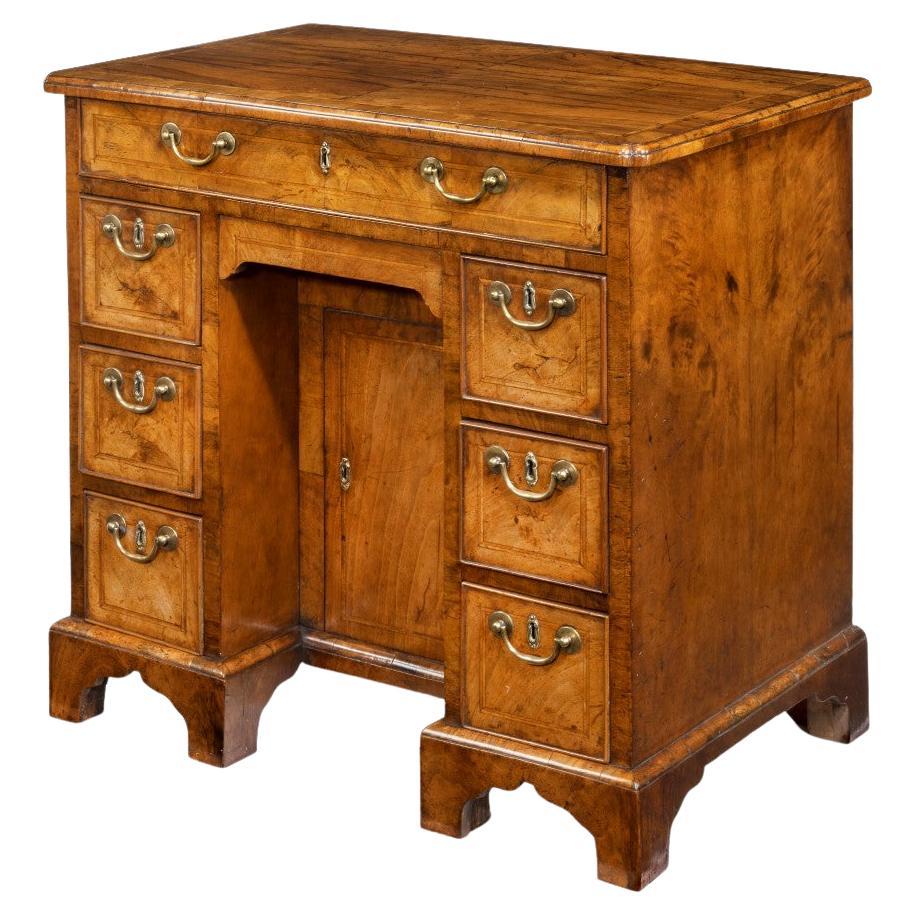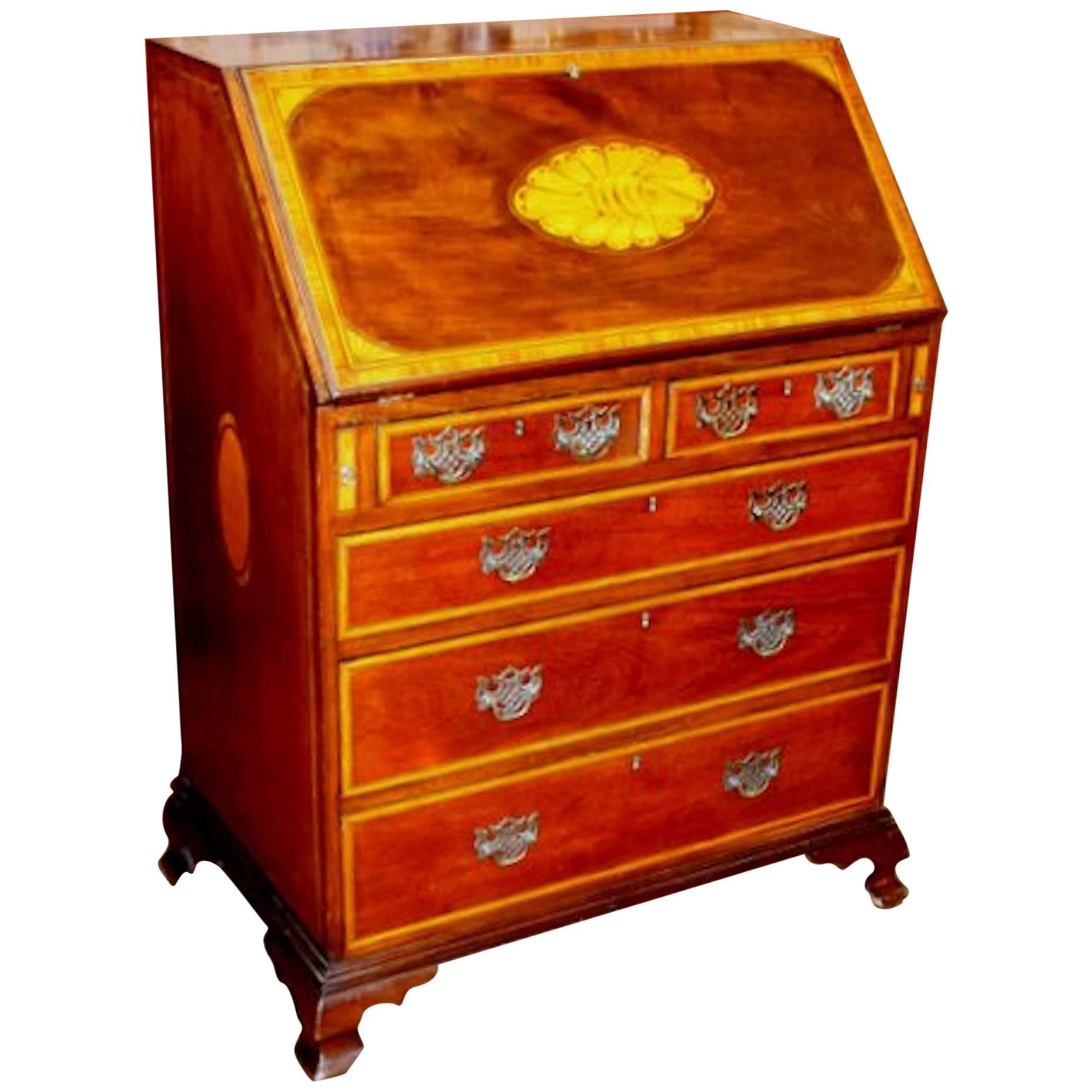Items Similar to Small George I Walnut Bureau on Stand
Video Loading
Want more images or videos?
Request additional images or videos from the seller
1 of 14
Small George I Walnut Bureau on Stand
About the Item
George I period walnut bureau or desk on stand, of compact proportions, ca 1720.
This small early Georgian desk is veneered in walnut and, unusually, is banded in yew wood. The well-drawn cabriole supports are carved with shells, a further indicator of quality, and of a date ca 1720. It has a stepped and fitted interior. Brass mounts are original.
Great old colour and patina, to fit into any interior. This is rare - most of this form on offer today will be reproductions.
From a private titled estate.
Literature:
'The Present State of Old English Furniture' R. W. Symonds, Duckworth, London (1921) fig. 33 ''a walnut veneered bureau ca 1725.''
Also p. 76, ill. 12, a walnut bureau on stand ca 1715 surmounted by a mirror (sic).
'The Shorter Dictionary of English Furniture' Ralph Edwards CBE FSA, p. 75. ill. 9, and dated 1715.
Refs:
See Christie's London, 19th October 2000 - a walnut bureau on cabriole legs (with a cabinet) ca 1710, sold @ £17,000.
Antique bureaux started out as small writing boxes with hinged lids, made mostly in oak, and date from the 17th century.
As people became more literate these individual boxes (often referred to as bible boxes) were raised up on stands and from about 1710 appeared on cabriole legs - the height of fashion as Queen Anne came to the throne.
The bureau, or writing box, was then set on a chest of drawers for a short time and then morphed, after about 1730, into the ubiquitous bureaux familiar to us today.
- Dimensions:Height: 40.16 in (102 cm)Width: 29.93 in (76 cm)Depth: 19.3 in (49 cm)
- Style:Georgian (Of the Period)
- Materials and Techniques:
- Place of Origin:
- Period:
- Date of Manufacture:circa 1720
- Condition:Wear consistent with age and use. Great old colour and patina, to fit into any interior. This is rare - most of this form on offer today will be reproductions.
- Seller Location:Lymington, GB
- Reference Number:
About the Seller
5.0
Vetted Seller
These experienced sellers undergo a comprehensive evaluation by our team of in-house experts.
Established in 1957
1stDibs seller since 2018
33 sales on 1stDibs
Typical response time: 19 hours
- ShippingRetrieving quote...Ships From: Lymington, United Kingdom
- Return PolicyA return for this item may be initiated within 14 days of delivery.
More From This SellerView All
- George I Walnut Secretaire Kneehole DeskLocated in Lymington, GBAn English early 18th century walnut secrétaire kneehole desk. George I period (1714-1727), c 1720. Of exceptional waxed honey color and lovely old patina, with well-matched veneers. With a quarter-veneered top. Six short drawers below a hinged fall revealing a writing section, all surrounding a central recessed cupboard. There is a small, shaped pull-out drawer fitted in the apron. All finely inlaid with herringbone lines. Raised on its original bracket feet. Swan-neck handles probably fitted later in the 18th century. Locks and keys are mostly original. Walnut veneered and crossbanded sides. Nb. Having a fitted secrétaire drawer distinguishes this antique walnut kneehole desk...Category
Antique Early 18th Century English George I Desks
MaterialsWalnut
- George III Period Mahogany Partner's Desk, circa 1800Located in Lymington, GBA George III-period mahogany partner’s desk, circa 1800. This is a very good quality Georgian English partner’s desk of classic proportions. Excellent deep, rich color and patinatio...Category
Antique Early 1800s English George III Desks and Writing Tables
MaterialsMahogany
- A rare small early-18th century walnut bureau bookcase/ cabinetLocated in Lymington, GBA rare, small, English George I / II- period walnut bureau bookcase/ cabinet with a moulded swan-neck pediment. Circa 1727-1730. The bevelled mirror plate has a candle slide below. ...Category
Antique 18th Century English George I Bookcases
MaterialsWalnut
- George II Mahogany Bureau Cabinet BookcaseLocated in Lymington, GBA very impressive mahogany bureau cabinet / bookcase / secretary*, with secret compartments. In the manner of Giles Grendey (1693-1780). In mahogany and parcel gilt. Mid-18th century, George II period. This English bureau cabinet displays fine, deep, rich colour and superb surface patination throughout. The top section with a broken-arch pediment and dentil cornice. The frieze well carved with Gothic arcaded blind fretwork. Centred by a later urn-shaped finial. The cabinet with two carved parcel-gilt gesso bordered ogee shaped doors. Old but apparently later mirror plates enclosing a fitted interior with eight drawers and adjustable shelves. The cleated fall, with its original lock, now fitted with a wine red, gilt-tooled writing surface revealing an exceptionally high-quality arrangement of canopied drawers and pigeon holes. The interior is centred by an arched, architectural over door...Category
Antique 18th Century English George II Bookcases
MaterialsMahogany
- George II Mahogany Bureau Cabinet BookcaseLocated in Lymington, GBAn 18th-century mahogany bureau cabinet of impressive architectural form and lovely rich color. George II period, circa 1740. The top surmounted by a bold architectural pediment and centered by a brass finial. The two arched panel doors reveal three adjustable shelves which have candle slides below them. Furthermore, the bureau section is fitted with a stepped interior. This has two secret compartments, drawers and pigeon holes, and the fall is conventionally supported on two lopers. Lined in the best quality English oak. The blind doors of this Georgian cabinet have well-figured mahogany panels of very good rich color which reflect beautifully in the candle light. The chamfered and arched doors display a further level of sophistication and quality. The beautifully-drawn arched pediment is in perfect proportion with the rest of the cabinet / bookcase. In excellent condition overall. Architectural furniture designs on the continent commenced with the arrival of the Renaissance, and they have their origins in Roman and Greek architecture. Nb. Bureau bookcases display books, china or silver behind glazed doors, but are described more accurately as bureau cabinets when they are fitted with blind doors. We often refer to antique bookcases / cabinets as ''secretary desks'' in the US. Information on pediments: 'Illustrated Dictionary...Category
Antique 1740s English George II Cabinets
MaterialsGlass, Mahogany
- Fine Chippendale Period Satinwood and Marquetry DeskLocated in Lymington, GBA fine Chippendale-period satinwood and marquetry desk. English, George III period, circa 1770. The considerable use of the best quality mahogany in the carcass is typical of the very fine work of Thomas Chippendale. It is rare today to find an 18th-century satinwood and marquetry-inlaid desk of this quality. (Most offered on the market are 19th/ 20th century). Major, period satinwood pieces have become almost unobtainable. The superbly-controlled and delicate marquetry inlays are reminiscent of the fine decoration on the famous Diana and Minerva Commode by Chippendale at Harewood House...Category
Antique 18th Century English George III Desks
MaterialsSatinwood
You May Also Like
- Small Georgian Elm BureauLocated in Bedfordshire, GBA delightful early 18th century George I Period Elm bureau of diminutive proportions having well figured fall front enclosing drawers and pigeon holes over two short and three lo...Category
Antique Early 18th Century English George I Desks
MaterialsElm
- Gustavian Neoclassical Mahogany Writing Chest / Bureau on High Stand, 1800sLocated in Lucenec, SKSwedish Gustavian mahogany writing cabinet. The writing part is covered with a black patent leather, with visible traces of use. The inner drawers have bone handles. The upper part i...Category
Antique 19th Century French Neoclassical Desks and Writing Tables
MaterialsBrass
- George I Walnut Kneehole DeskLocated in Essex, MANicely figured walnut, rectangular quarter veneer top over top over a drawer and kneehole with door and small drawer flanked by drawers raised on bracket feet.Category
Antique Early 18th Century English George I Desks
MaterialsOther
- Early George III Walnut Kneehole DeskLocated in Lymington, HampshireAn early George III walnut kneehole desk, the shaped rectangular top quarter veneered with re-entrant corners and herring bone cross-banding, with one long drawer above a disguised d...Category
Antique 1760s English George III Desks and Writing Tables
MaterialsWalnut
- Antique English Inlaid Figured Mahogany Georgian Style Small Slant-Front BureauLocated in Charleston, SCExceptional quality antique English fabulously inlaid figured mahogany Georgian style small slant-front bureau with handsome fitted interior and leather writing surface Please not...Category
Antique Late 19th Century English George III Desks
MaterialsLeather, Mahogany, Rosewood, Satinwood
- George 11nd small Kneehole Desk in Mahogany, English Circa 1745Located in Lincoln, LincolnshireThis is a fine original antique kneehole desk or dressing table from the mid-18th century, thought to have the provenance of being part of the es...Category
Antique Mid-18th Century English George II Desks
MaterialsHardwood
Recently Viewed
View AllMore Ways To Browse
Antique English Furniture
English Antique Furniture
English Furniture Antique
On Stand
Old Time Pieces
Old English Furniture
Small Walnut Cabinet
Small Storage Walnut
Small Antique Storage
Antique Small Storage
Old English Antique Furniture
Small Antique Storage Pieces
England Small Cabinet
Small Desks
Desk On Stand
Small Raised Cabinet
Walnut Cabinet On Stand
Cabinet On Carved Stand
